The ASUS VG278Q is one of the first G-SYNC compatible FreeSync enabled displays to launch this first quarter of the year. Coming in hot with 144Hz support at around $350 USD or about 16995 Pesos, the latest display from ASUS also sports ELMB at 120Hz.
ASUS markets the ASUS VG278Q as an eSports gaming monitor and there’s no reason why it shouldn’t be one based on the specifications alone. That includes a 1ms response time, the 144Hz refresh rate, adaptive sync support and a slew of other gaming centric features. Are ASUS’s claims really on point? Are better choices out there? We will find that out on this review.
TECHNICAL SPECIFICATIONS:
|
Display |
|
| Size | 24″ |
| Aspect Ratio | 16:9 |
| Resolution | 1920 x 1080 |
| Refresh Rate | 144Hz |
| Display Area | 597.6 x 336.15mm |
| Pixel Pitch | 0.311mm |
| Brightness | 400cd/㎡ |
| Contrast Ratio | 1000:1 |
| DCR | 100000000:1 |
| Panel Type | TN |
| Response Time | 1ms |
|
Connectivity |
|
| Input/Output Connector | HDMI, DisplayPort, DVI-D |
| USB/Audio | 3.5mm audio out |
| Ergonomics | |
| VESA Wall Mount | 100 x 100mm |
| Pivot | -90°/+90° |
| Swivel | -90°/+90° |
| Tilt | -5°/+33° |
| Hight Adjustment | 0-130mm |
DESIGN, LAYOUT AND CONNECTIVITY:
The ASUS VG278Q looks like one of their standard gaming monitors. Design is neat, doesn’t stand out much and will most likely fit any desktops nicely. At 27″ inches, the display is pushing 1080P at its limits. The not so great PPI at 81.59 is something that you need to be aware of.
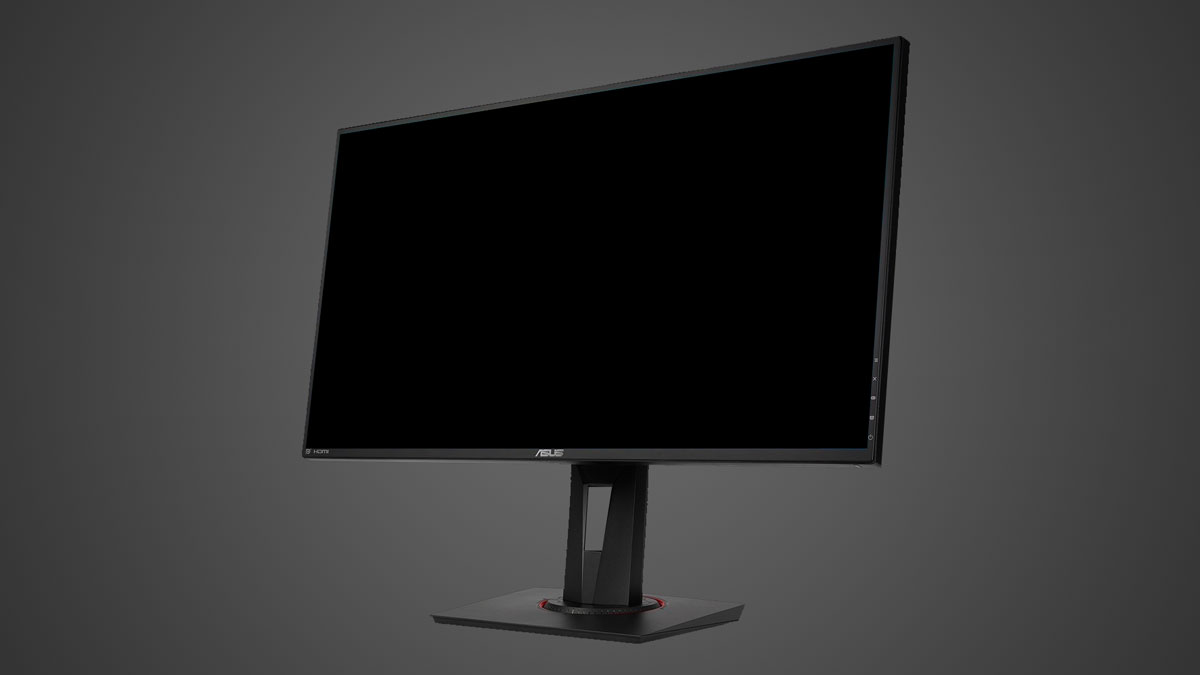
Screen coating used is a blend between gloss and a matte finish. A usual feature found on most gaming displays. Bezel is rather thin, which is a nice contrast compared to my aging ASUS MG278Q.
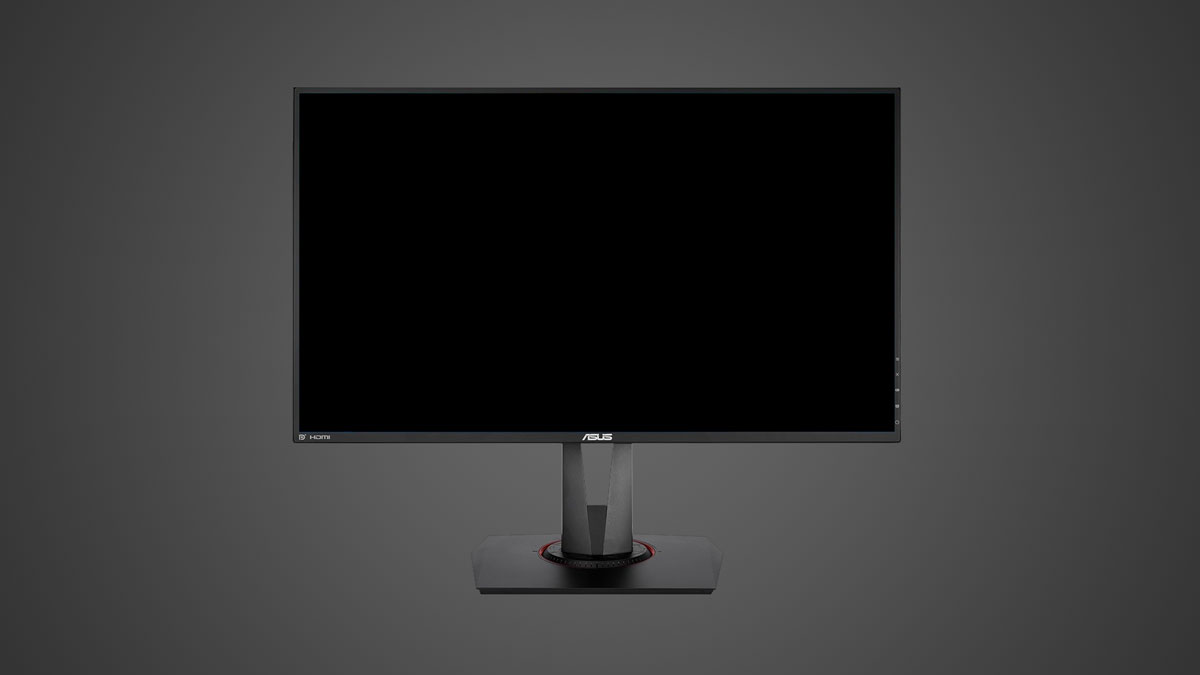
Ergonomically, the ASUS VG278Q could tilt, swivel and pivot on top of the VESA mountable design. This weights in at 3.2 kilograms without the stand so standard VESA mounts could lift it without a fuss.
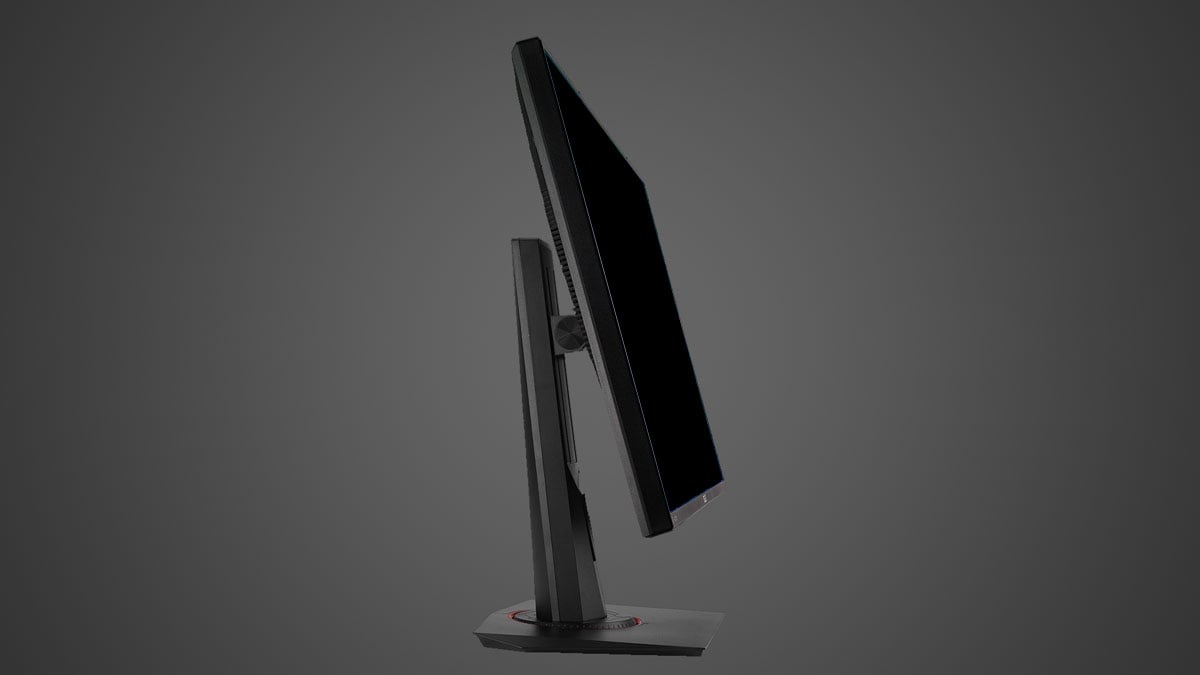
As for display options, ASUS went with a single HDMI, Display and a DVI-D port. We also got an audio out but I’d rather see a USB option here.
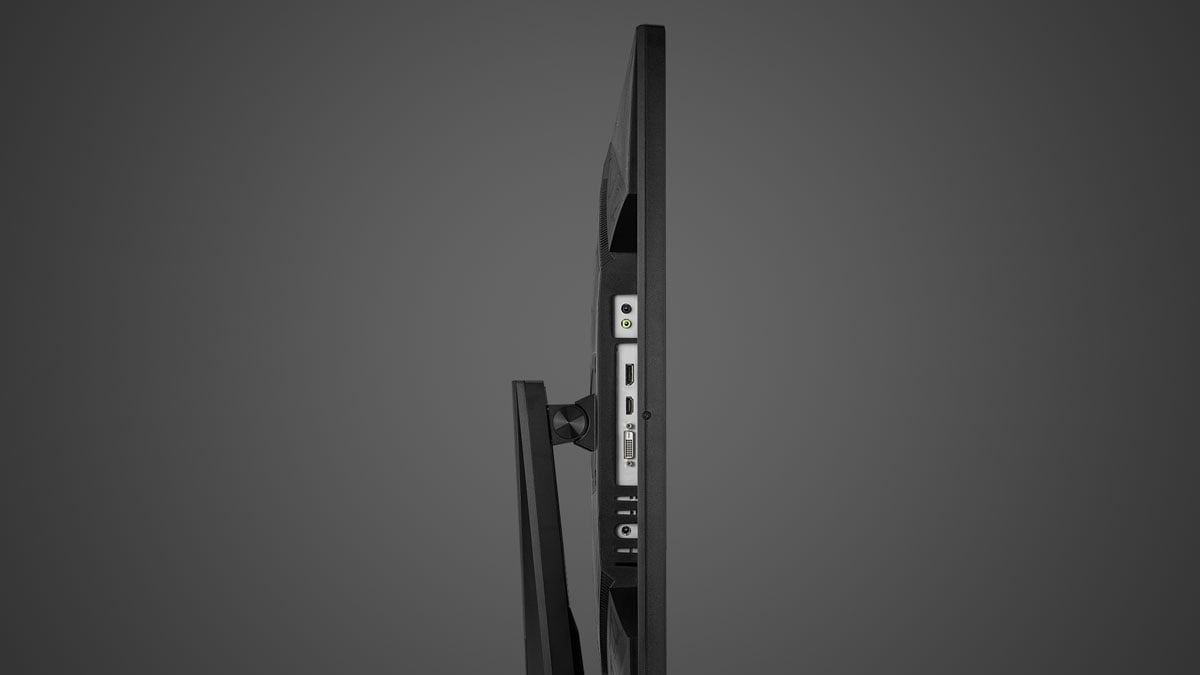
Power is unfortunately external but we do have dual 2W RMS speakers.
ON-SCREEN DISPLAY MENU:
The ASUS VG278Q features a familiar easy to use joystick enabled OSD. We have 8 main menus here with the GameVisual, Color and Image menus being the most important ones out of the bunch.
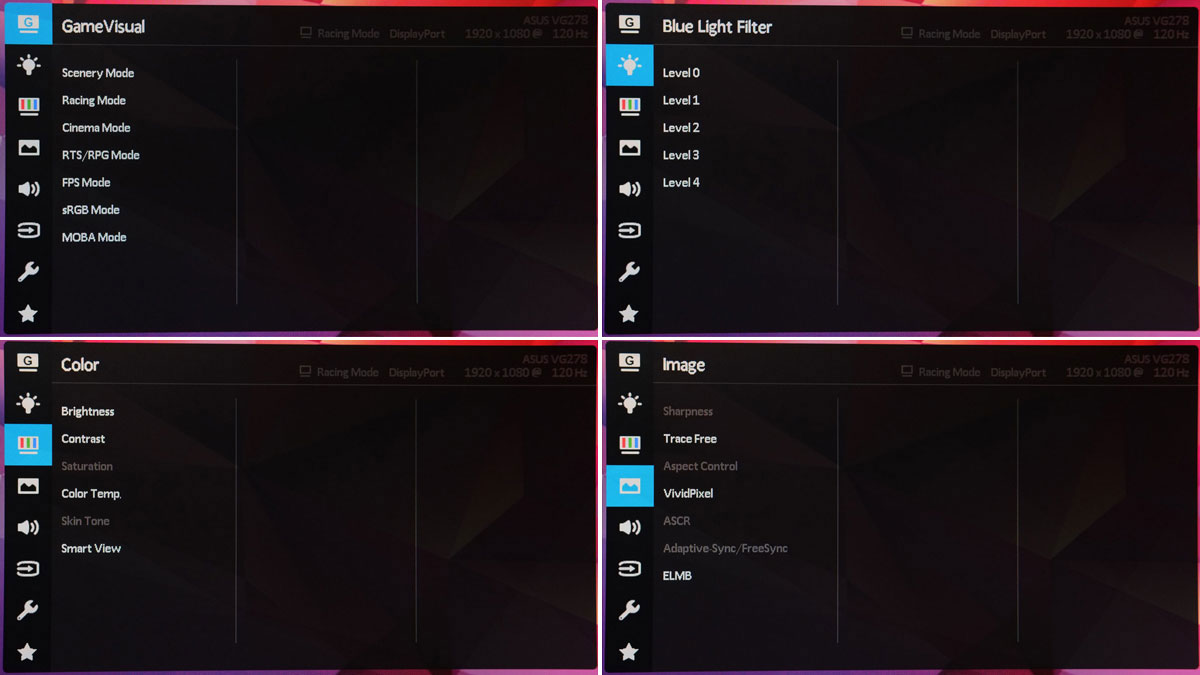
Perhaps what I find annoying are the locked Color options for certain GameVisual presets. The lack of Gamma adjustment settings doesn’t help either so perhaps ASUS could really use an overhaul of the OSD. Maybe ASUS could just add another preset that we could use to fine tune everything on our own?
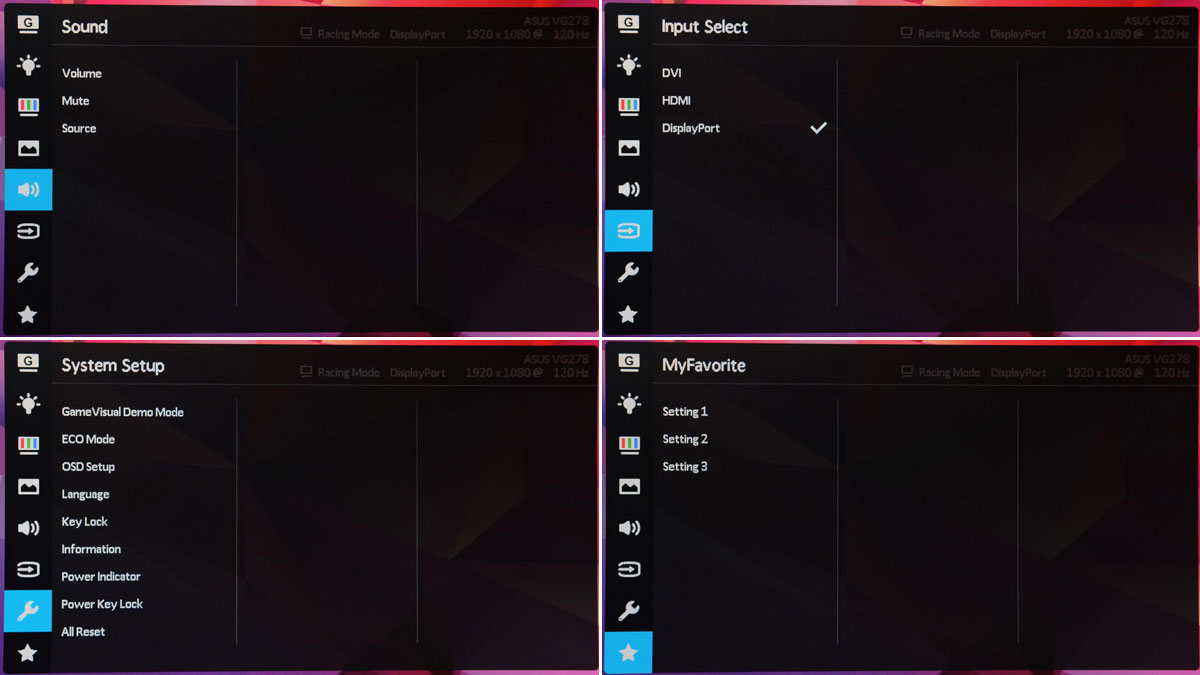
TEST SETUP AND METHODOLOGY:
Our test setup relies on the Blur Busters TestUFO Motion Tests and the Data Color Spyder5ELITE Display Calibration System. The cameras used throughout the review for the motion artifact and high speed assessments are the Fujifilm XE-1 and the Nikon 1 J1.
| TEST SYSTEM SPECIFICATIONS | |
| PROCESSOR | Intel Core i5 6600K |
| MOTHERBOARD | ASUS Z170-A |
| COOLER | Cryorig C1 Top Flow |
| MEMORY | Crucial Ballistix Tactical DDR4 @ 2666MHz 2x4GB |
| GRAPHICS | ASUS ROG STRIX GTX 1060 OC 6GB |
| STORAGE | Crucial BX200 480GB |
| POWER | Corsair RM850X 850W |
| DISPLAY | ASUS MG278Q |
| OS | Microsoft Windows 10 Pro |
Target for calibration is a 2.2 Gamma value, with a White Point at 6500K and a Brightness value set at 120 cd/㎡. Calibrated values are then analyzed with the Spyder5ELITE Display Analysis tool. Do note that Dynamic Contrast Ratio and other extra features built within the OSD are disabled during the tests. The following OSD values are selected for the display calibration.
| OSD Settings | |
| Brightness | 28 |
| Contrast | 80 |
| Saturation | NA |
| Temperature | User |
| Gamma | NA |
| Preset | Racing |
If you wish to use the calibrated ICC profile taken from our Spyder5ELITE result, just send us a message. You may also read our guide on how to use ICC profiles.
GAMUT:
The Gamut test evaluates the color spaces the display exactly covers. That includes industry standard spaces such as sRGB and AdobeRGB. Higher percentage values are better.
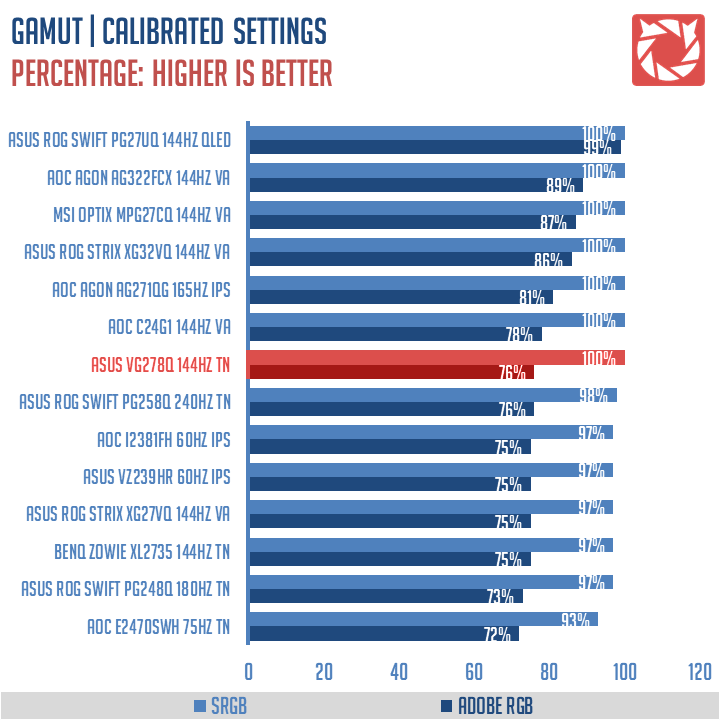
The ASUS VG278Q’s color space coverage is generally good. We got a 100% sRGB coverage while AdobeRGB results are at 76%.
TONE RESPONSE:
Tone response is where we check the display’s Gamma values and or presets if there are any. We then compare the results with industry standards of 1.8, 2.2 and 2.4. Closer to these values are better.
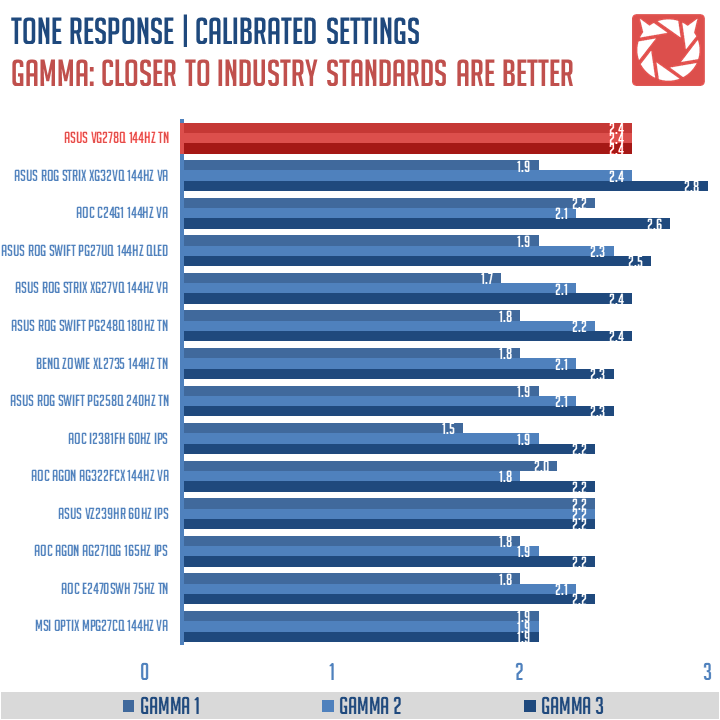
The ASUS VG278Q doesn’t feature any gamma level adjustment option but you may get a lower or higher level depending on the presets you choose. For an instance, a gamma level of 2.4 is the mainstay level on our selected Racing mode.
BRIGHTNESS AND CONTRAST:
The result of the tests shows us an overview on how the display actually performs in terms of Brightness and Contrast ratio on varying brightness levels. Higher is better.
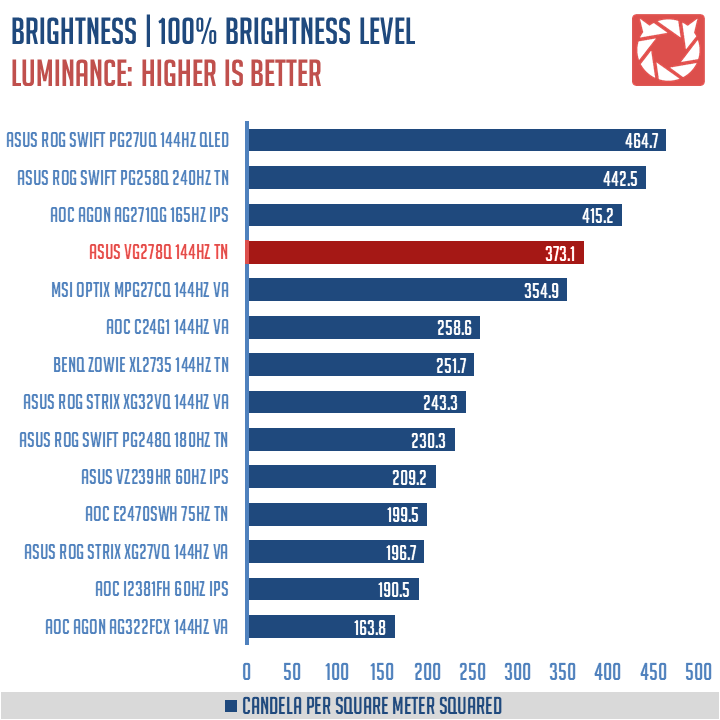
Brightness at 100% using our calibrated profile is rated at 373.1 cd/㎡. Contrast ratio at 100% contrast on the other hand is at 900:1. Good values we got here to be honest.
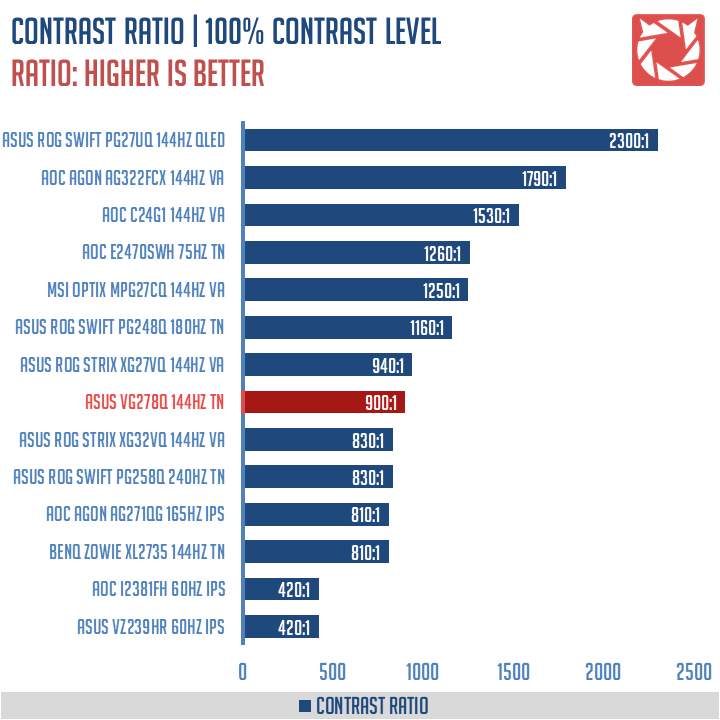
SCREEN UNIFORMITY:
This test shows us an overview of the screen’s uniformity at the calibrated brightness level. The closer this value to 0, the better the performance of the panel.
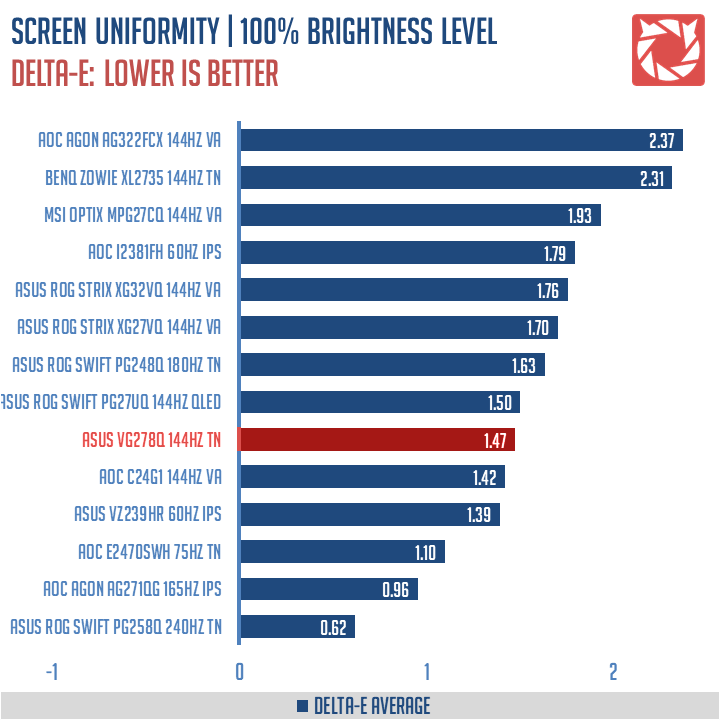
Screen uniformity is what I could say near the middle of the pack with a Delta-E value of 1.47 average.
COLOR ACCURACY:
This test shows how well different basic color hues are being reproduced by the display. These color tones correspond with the Datacolor SpyderCheckr. Lower Delta-E values are better.
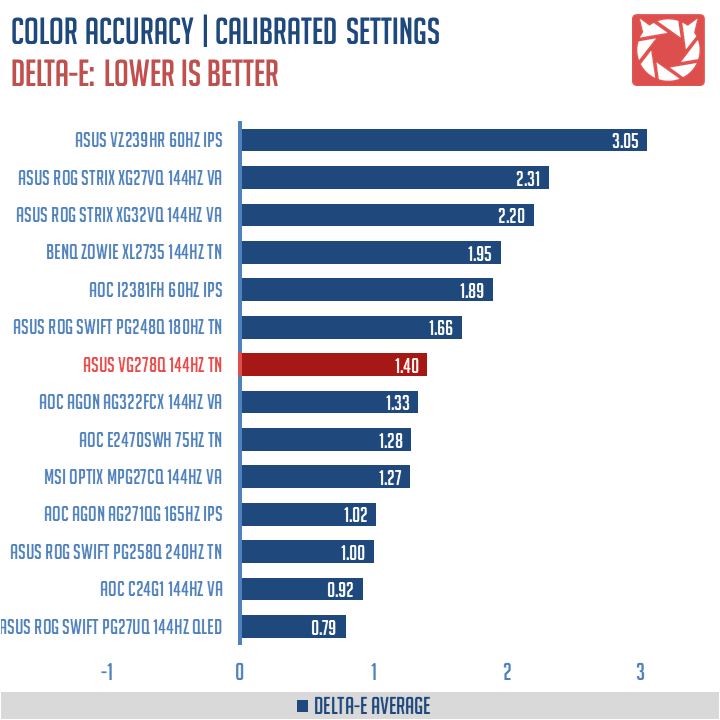
The ASUS VG278Q scored an average of 1.40 Delta-E value. Decent result we got here, even beating some of the most popular displays on the review.
POWER CONSUMPTION:
The power consumption is checked with a power meter. Measurements are taken at maximum brightness level.
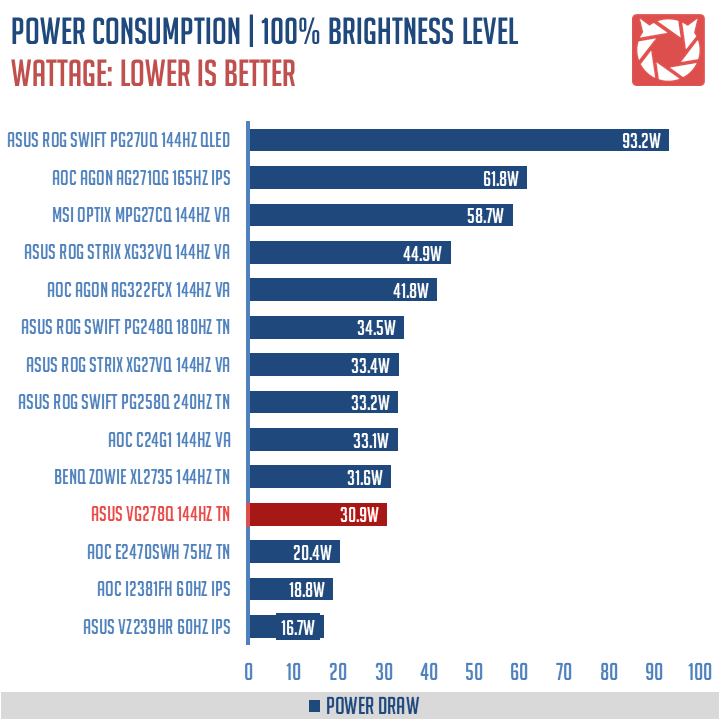
The ASUS VG278Q power consumption is at 30.9W. The most power efficient 27″ 1080P display we’ve tested so far.
BACKLIGHT BLEED AND VIEWING ANGLES:
Backlight Bleed is the phenomenon where backlighting from a display leaks. This is prevalent with LED backlight enabled displays where the LEDs used to light the panel are situated at the edges of the display. Testing the Backlight of the display is conducted on a dim room, simulating the recognizable amount of bleed for such scenario.
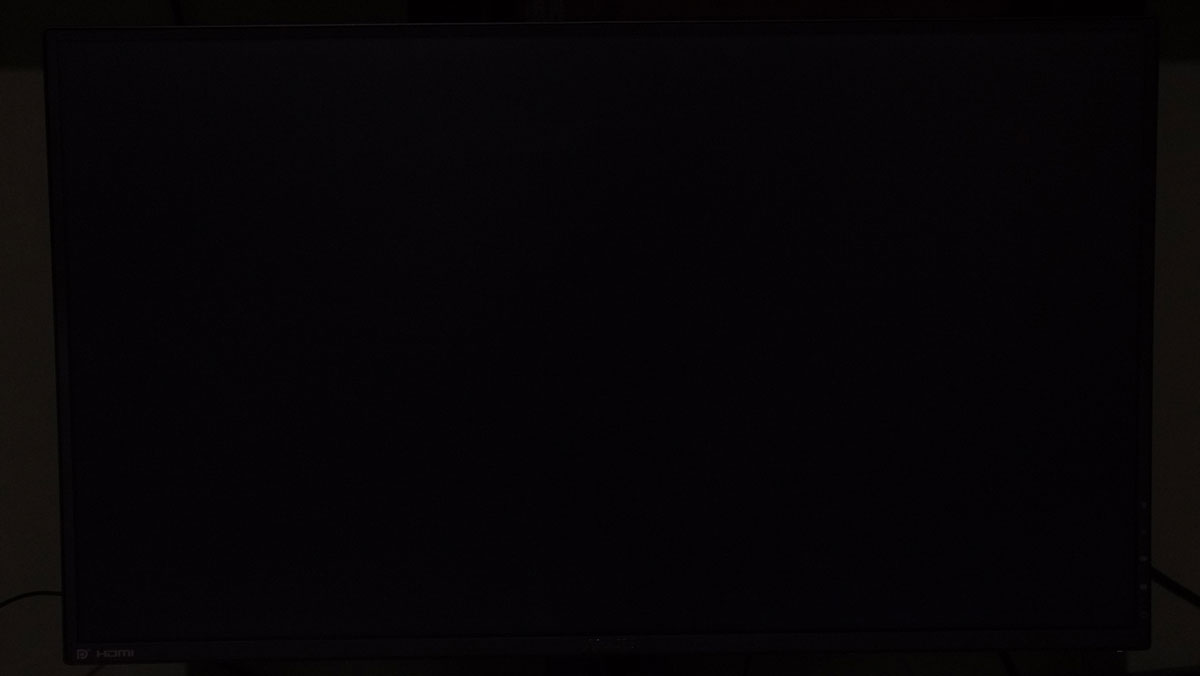
Viewing angles are also tested to check out how the display panel performs on various positions. This should be helpful if you are looking for a panel that could be used on multi-monitor setups.
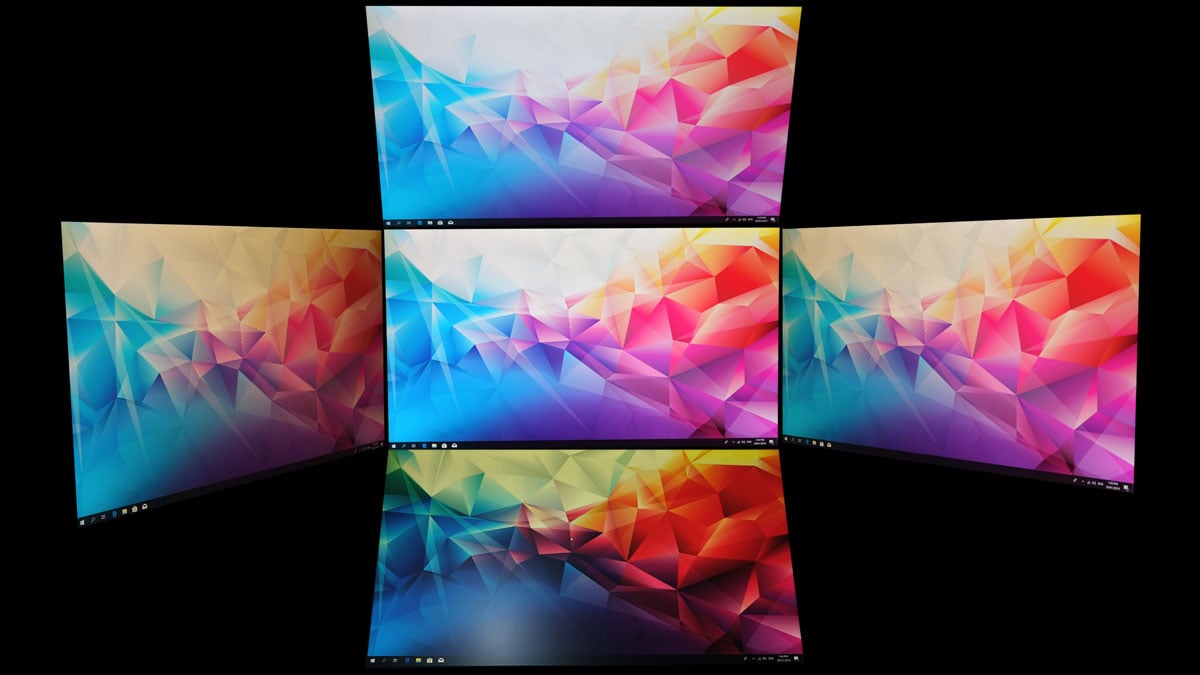
The backlight bleed of the ASUS VG278Q at 120 cd/㎡ is hardly noticeable. Viewing angles however are horrendous. The worst so far even compared to other TN panels we’ve tested.
BUTTON TO PIXEL INPUT LAG:
The Button to Pixel Input Lag is a combination of system latency from the point of input, processing and display output. That is the basic of it and to quantify the approximate Button to Pixel Input Lag, we utilized Quake 3 Arena as our main shooter. The game is set at the native resolution of the panel with the FPS locked at 250. We check how much delay in milliseconds it took the display to actually output the signal via a 1200 FPS high-speed camera with ~0.83ms of accuracy.
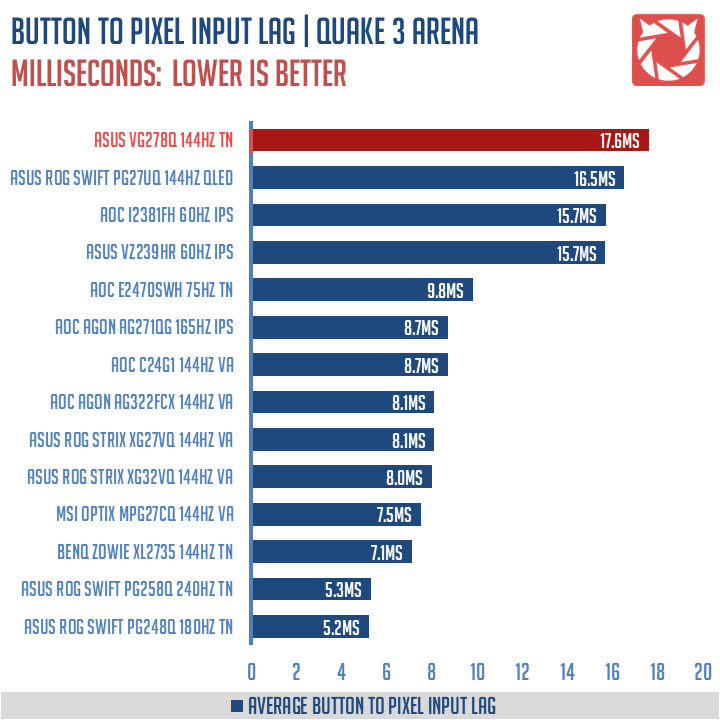
Our button to pixel lag results shows that the ASUS VG278Q has an average of 17.6ms of latency. The worst button to pixel lag result we’ve got.
FRAME SKIPPING:
Frame Skipping is the phenomenon where dropped frames and missing refreshes occur due to ineffective refresh rate overclocking. If your display exhibits such issues, it should be perceptually similar to in-game frame skipping. We are are utilizing the Blur Busters Frame Skipping Checker to test if there is any.
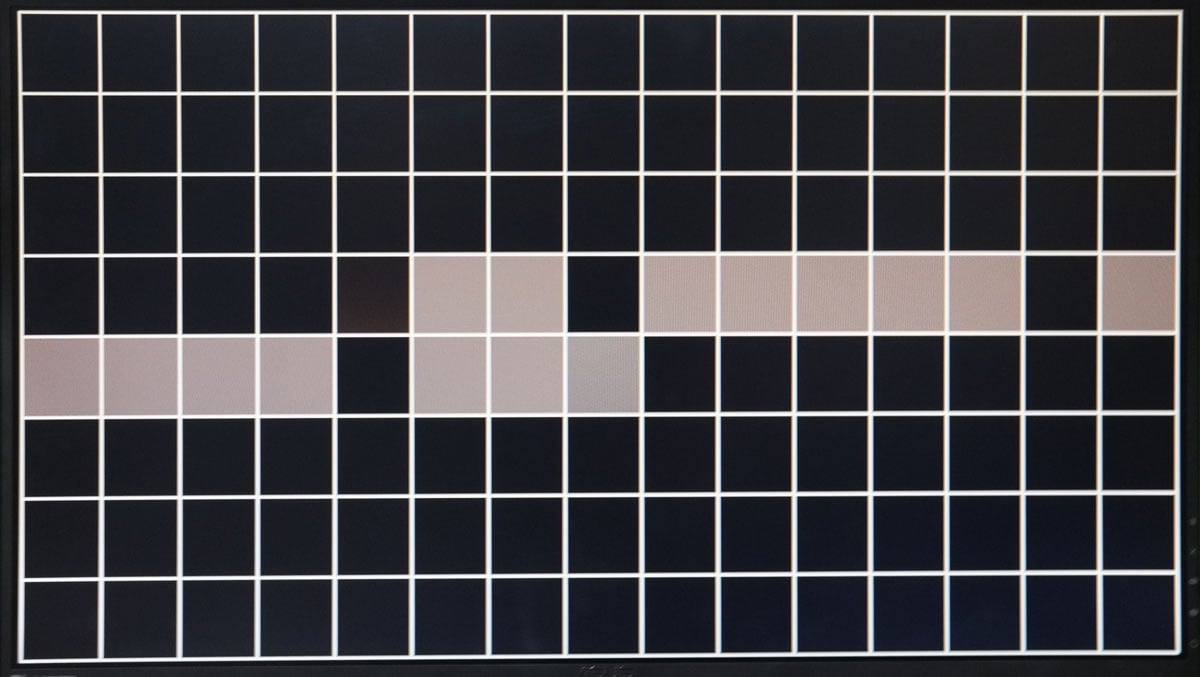
Unfortunately, the ASUS VG278Q also suffers from frame skipping at 144Hz (120Hz is flawless). I asked ASUS if this is just a problem with my unit, but I have yet to receive a concrete answer. This could also explain the mediocre button to pixel lag result we got from the display. Is my unit a lemon? Highly possible, since it also appears to be a retail unit. Only ASUS could tell.
MOTION CLARITY: DISPLAY PERSISTENCE
Motion Picture Response Time (MPRT) is the numbered approach to demonstrate the level of perceived motion blur on a display. Basically, a lower persistence value indicates less motion blur. Refresh rate and the sampling method plays a major part here whereas a higher refresh rate nominally features better display persistence values.
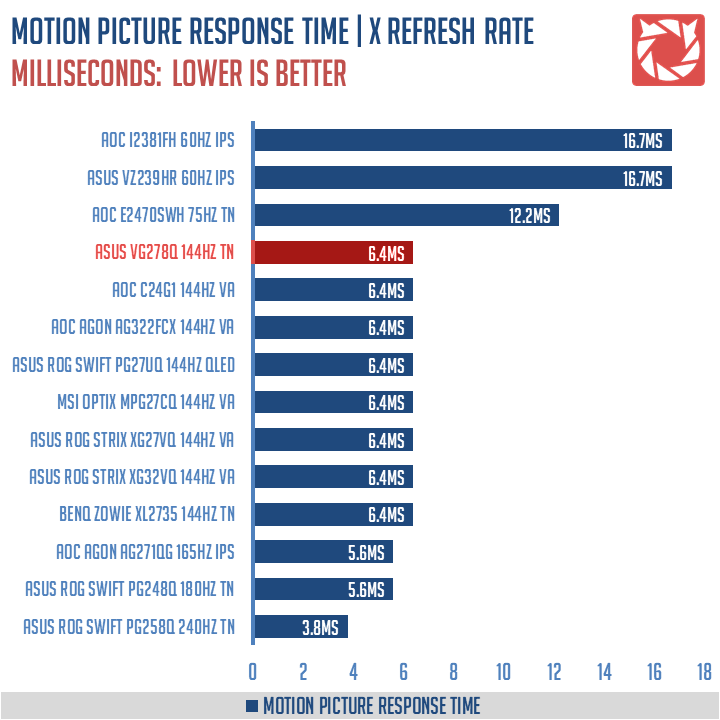
Assessing the typical display persistence is easy enough with sample and hold displays, while CRT and Strobe Lighting enabled displays are quite difficult to test with the current tools available. That said, these are still good references to check out. Especially true if we’re looking for differences based on refresh rates alone.
MOTION CLARITY: PURSUIT CAMERA
Setting up a pursuit camera courtesy of Blur Busters allows us to a great extent, perceive the actual motion blur of the display. Using such method also allows us to check out for other motion artifacts including ghosting, inverse ghosting and other artifacts. This pursuit camera test is a peer-reviewed invention.
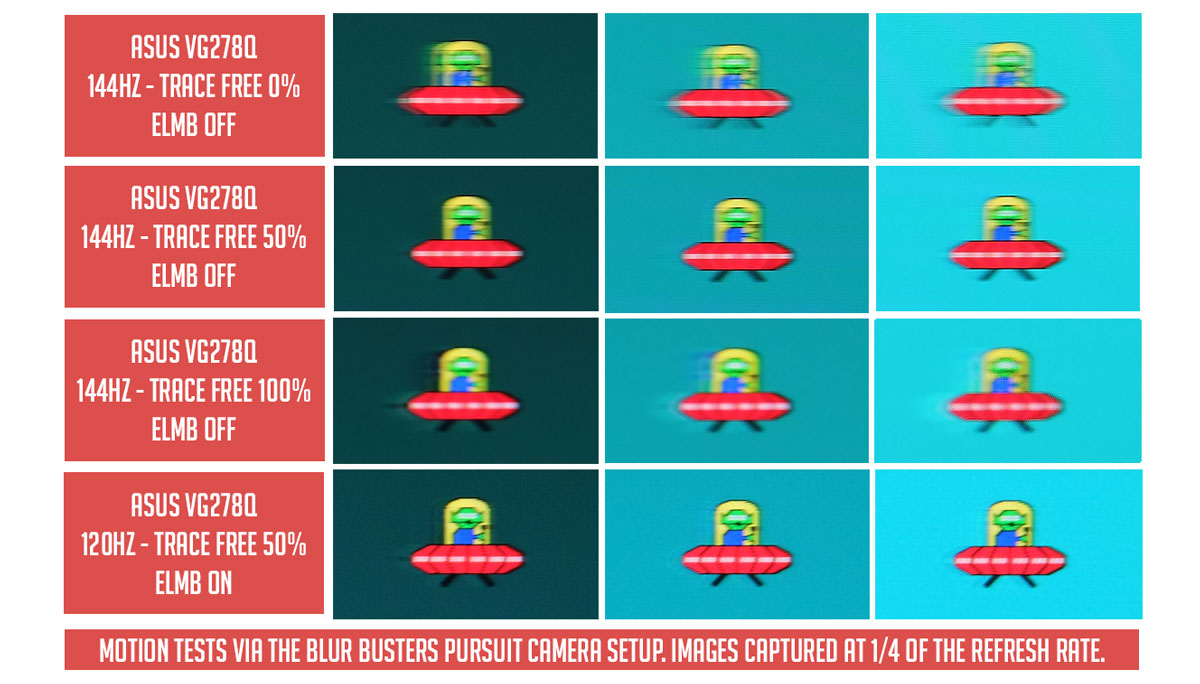
Motion clarity wise, we are looking at a display with around 1-2ms MPRT. That’s with the Trace Free at 50% and ELMB turned on. Trace Free is best used at 50% under 144Hz, while it is just painful at 100%.
SOFTWARE, LIGHTING AND SPECIAL FEATURES:
The ASUS VG278Q comes equipped with support for Adaptive Sync which means it supports AMD FreeSync and is certified Nvidia G-SYNC compatible. This means that if you have an Nvidia or an AMD graphics card, you could use the adaptive sync technology of the monitor regardless. This is a great feature if you absolutely hate screen tearing but be aware of the input lag it may induce.
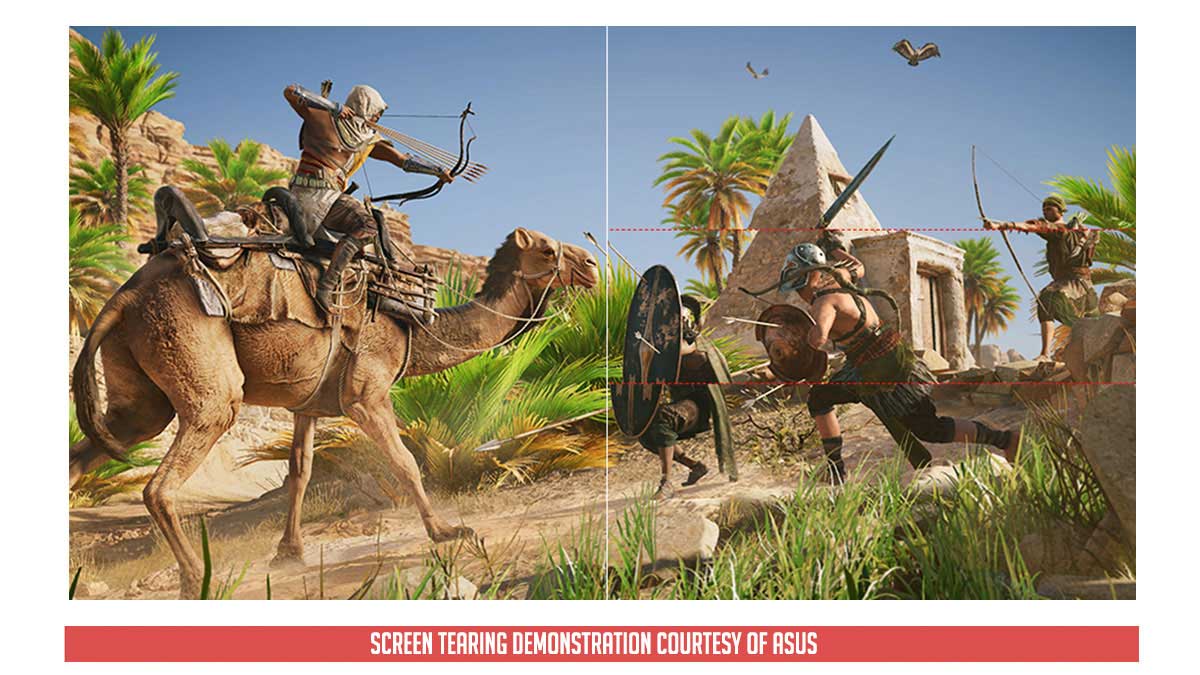
The VG278Q also features ASUS’ own ULMB called ELMB. This is an excellent feature to reduce motion blur, even better when paired with the ASUS Trace Free at 50%. The drawbacks though is that you have to maintain your frame rate, it is technically locked at 120Hz and cannot be used with Adaptive Sync.

Other features includes flicker-free backlight, hotkeys for the ASUS GamePlus in-game enhancements and many more. Please refer to the official product link for more information.
FINAL THOUGHTS:
The ASUS VG278Q is supposed to be an excellent gaming display for its price point. We have Adaptive Sync support for both AMD and Nvidia, an in-house Anti-motion Blur technology built-in and a panel that offers good color space coverage and zero backlight bleed on top of its other game centric features. But we have one concern here and that’s frame skipping at 144Hz.
Granted, it shouldn’t be an issue since I may be dealing with a lemon unit here and ASUS appears to conclude the same. Regardless and if it is indeed the case, then it is possible that other units might suffer the same issue. I have tried everything to check out the cause of the issue (changed cables, ports, components, etc) but alas, I couldn’t figure out what’s up with it. The only solution I could find is to either lower the refresh rate at 120Hz or have it configured using a custom resolution tool.
The poor viewing angles and button to pixel input lag are also nothing to scoff at. I could actually live with the viewing angles but the input lag is just insane on top of the frame skipping issue. If you are not heavy invested on a competitive level this certainly wouldn’t hurt as a daily driver but if you are like me who thinks that every millisecond and frames count then this is not the display to go with. Then again, the unit I got could be a lemon.
Overall the ASUS VG278Q is still a value oriented 27 inch TN display at 16995 Pesos with clear trade offs. If you have the cash to spend and you already got that cpu and gpu combo for competitive 144Hz gaming, then you need to look elsewhere.
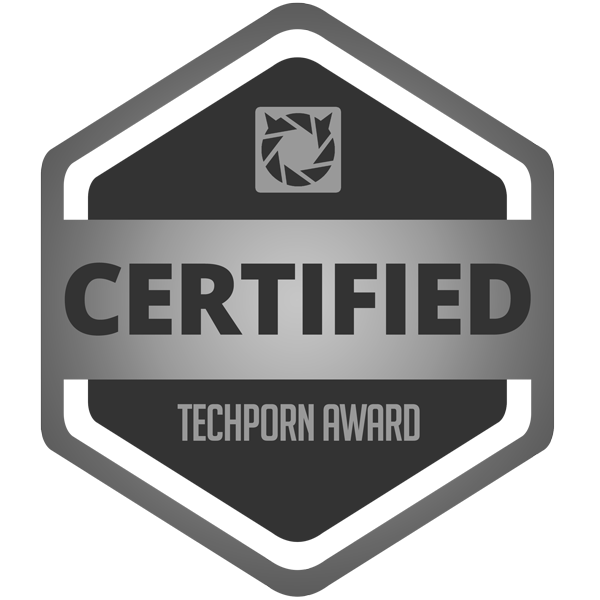
ASUS VG278Q Gaming Monitor Review
-
PERFORMANCE - 6/10
6/10
-
BUILD QUALITY - 6/10
6/10
-
FEATURES - 8/10
8/10
-
AESTHETICS - 9/10
9/10
-
VALUE - 8/10
8/10
Summary
Overall the ASUS VG278Q is still a value oriented 27 inch TN display at 16995 Pesos with clear trade offs. Definitely not a competitive grade gaming monitor though with the issues in-tow.
Pros
- GOOD COLOR SPACE COVERAGE
- POWER EFFICIENT 27″ PANEL
- DECENT CONTRAST, GOOD BRIGHTNESS LEVELS
- ZERO BACKLIGHT BLEED
- EXCELLENT PRICE POINT
- GAME CENTRIC OSD FEATURES
- G-SYNC AND FREESYNC COMPATIBLE
- EXCELLENT ERGONOMICS
Cons
- FRAME SKIPPING AT 144HZ (POSSIBLE LEMON)
- POOR VIEWING ANGLES
- BUTTON TO PIXEL INPUT LAG
- NO GAMMA SETTINGS AVAILABLE
Leo, just wondering how you arrived at an input lag of 17.6ms when other reviews on other sites are suggesting input lag is around 4ms? How on earth do you get 4 x the amount the they got or how did they get 4x less than you got? I’ve never seen such different ratings. 17.6 ms would make it slower than many televisions would it not?
Hi Any,
My method to test input lag is via button to pixel input lag. Basically, that’s the latency from the input(keyboard) to the output (monitor) recorded by a 1200FPS camera.
I agree, something was either wrong with the monitor, or the methodology. Either way, gotta take a result like that as an absolute outlier.
Hi! When you noticed the frame skipping, was the monitor coupled via HDMI or Displayport?
It is connected via a DisplayPort 1.4 cable.
Did you test this with the low input-lag mode? It isn’t mentioned in the write-up and you got much higher results than other sites so maybe something to confirm….
Hi! Yes, I have tested everything. Problem is frame skipping on top of our method to check the display’s overall latency. If it skips a frame during our capture, then it would contribute to the result. It does that 100% of the time.